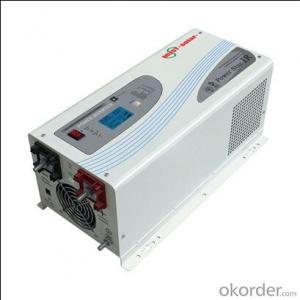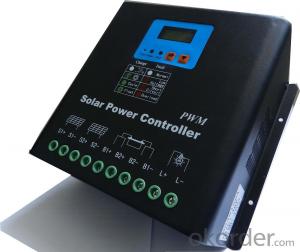Off-Grid Low Frequency PV Inverter EP3200 Series 4KW-6KW
- Loading Port:
- China main port
- Payment Terms:
- TT or LC
- Min Order Qty:
- 50 unit
- Supply Capability:
- 1000 unit/month
OKorder Service Pledge
OKorder Financial Service
You Might Also Like
1. Structure of Off-Grid Low Frequency PV Inverter Description
EP3200 series off-grid low frequency PV inverter adopt very new model copper transformer so the efficiency reach to 90% and lower
consumption (NEW !)
Pure sine wave solar hybrid inverter for solar system and home appliances . EP3200 series off-grid low frequency PV inverter developed on
the base of our very popular EP3000 series . EP3200 has achieved significant improvements on battery charging , AC transfer , bypass
etc .
By adopting DIP(Dual-in-line) switch , EP3200 series off-grid low frequency PV inverter provides more smarter options for users to
customize the performance of the device . Main for home solar system including air conditioner , refrigerator , washing machine , water
pump , fans , tv , lights etc.
2. Main Features of the Off-Grid Low Frequency PV Inverter
• High overload ability of our EP3200 charger is up to 300% rated power
• EP3200 pure sine wave inverter adopts low quiescent current, and power saver mode to reduce power consumption to 3W . It can extract
max. power from various batteries with different protections, and low voltage trip can be selected (10V/10.5V/11V).
• Uses PFC (power factor correction) for charger, which has less power consumption than conventional units.
• It has 10s delay before transfer when AC resumes, and overload protection when our APC pure sine wave inverter equips with generator.
• 10ms typical transfer time between battery and AC, which guarantees power continuity of EP3200 charger. Uses selectable input AC
voltage (185-265V or 155-255V) for different kinds of loads.
• Our EP3200 charger allows start up and through power with depleted batteries. Its powerful charge rate up to 70Amp.
• It can offer 3-step intelligent battery charging, and equipped with 6 preset battery type selector for totally flat batteries.
• LCD status display, battery/AC priority switch, RS232 communication port are available for our EP3200 pure sine wave inverter, it also
has 17 alarms/warnings for easier operation and trouble-shooting, and ability to switch the unit on/off. In addition, select/deselect power
saver mode can be used too.
3. Off-Grid Low Frequency PV Inverter Images




4. Off-Grid Low Frequency PV Inverter Specification
Rated Capacity | 4000W | 5000W | 6000W | |
Efficiency | >90% | |||
Input | ||||
Model | 120v Models | 230v Models | ||
Nominal Voltage | 100V/110V/115V/120VSelectable | 200V/220V/230V/240V Selectable | ||
Output | ||||
Rated Power | 4000W | 5000W | 6000W | |
Output Voltage | 100V/110V/115V/120V Selectable | 200V/220V/230V/240V Selectable | ||
Voltage Waveform | Pure Sine Wave | |||
Crest Factor | 3:01 | |||
Transfer Time | Transfer Time : AC To DC : 10ms (Typical) | |||
Transfer Time : DC To AC : 10ms(Typical ) | ||||
Max Bypass | 30A | |||
Overload Current | ||||
Input | ||||
Nominal Voltage | DC24V/48V | DC48V | DC48V | |
Over Current Protection | By Re-Settable Over Current Protector | |||
Output | ||||
Regulation (Nominal) | ±10% Typical Of Nominal Voltage | |||
Nominal Input Voltage | 230Vac | |||
Input Voltage Range | 185-265Vac | |||
Nominal Output Voltage | According To The Battery Type | |||
Nominal Charge Current | 30Amp-70Amp | |||
Battery Type | Lead-Acid 12Ah ~ 250Ah | |||
Typical Backup Time | No Limit | |||
Charging Method | Smart Pulse Charging With Two Charging Modes: | |||
Quick Charging When Battery Is Not Fully Charged, | ||||
Trickle Charging When Battery Is 90% Fully Charged. | ||||
Average Charging | 65A/35A | 70A/40A | 50A | |
Current | ||||
Battery Voltage options | ||||
Options 7 | Battery low trip to bypass 11v , high trip to battery 14v | |||
Options 8 | Battery low trip to bypass 10.5v , high trip to battery 13.5v | |||
Options 9 | Battery low trip to bypass 10v , high trip to battery 13v | |||
Communications & Management | ||||
Control Panel | LCD/LED Option | |||
Audible Alarm | Alarm On Battery: | |||
Low Battery & Battery Over Voltage | ||||
Alarm On Abnormal Operation: | ||||
Over Load, Short-Circuit, & Over Heat | ||||
Environment And Safe | ||||
Operating | 0℃ To 40℃ (32℉ To 104℉) | |||
Temperature | ||||
Transit/Storage | -15℃ To 60℃ | |||
Temperature | ||||
Audible Noise | 60 Dba Max at 1m | |||
Quality Control System | ISO 9001,FCC,CE | |||
Physical | ||||
Dimensions: (H×D×W) | 755*320*310mm | |||
G.W (Kg) | 37.5 | 47.5 | 47.5 | |
Packing | Export Carton For Each Unit Per Carton | |||
5. FAQ of Off-Grid Low Frequency PV Inverter
Q1. What is the difference between inverter and Off-Grid Low Frequency PV Inverter?
A1. Inverter only has AC inpput, but Off-Grid Low Frequency PV Inverter both connect to AC input and solar panel, it saves more power.
Q2. What is the difference between MPPT&PWM?
A2. MPPT has higher efficiency, it can track the max power point and won't waste energy.
Q3. What is the waranty of product?
A3. 12 months.
- Q: Is it possible to monitor the performance of a solar inverter remotely?
- Yes, it is possible to monitor the performance of a solar inverter remotely. Many modern solar inverters come with built-in monitoring capabilities that allow users to track and analyze the system's performance from a remote location. This can be done through dedicated monitoring portals or mobile applications which provide real-time data on energy production, system efficiency, and any potential issues or faults. Remote monitoring enables users to optimize the performance of their solar inverter, identify any maintenance or operational requirements, and ensure the system is operating at its maximum potential.
- Q: Can a solar inverter be used in conjunction with a smart home system?
- Yes, a solar inverter can be used in conjunction with a smart home system. In fact, many modern solar inverters are designed to integrate seamlessly with smart home technologies. This allows homeowners to monitor and control their solar energy production, consumption, and other connected devices through a centralized smart home system or smartphone app.
- Q: How does a solar inverter handle grid faults or disturbances?
- A solar inverter handles grid faults or disturbances by constantly monitoring the grid voltage and frequency. When a fault or disturbance is detected, the solar inverter will disconnect from the grid within a few milliseconds to ensure the safety and stability of the system. It will then enter a standby mode until the grid fault is resolved. Once the grid is back to normal, the solar inverter will reconnect and resume normal operation, providing power to the grid and maintaining synchronization.
- Q: Can a solar inverter be used with a solar-powered healthcare system?
- Yes, a solar inverter can be used with a solar-powered healthcare system. A solar inverter is an essential component of a solar power system as it converts the direct current (DC) produced by solar panels into alternating current (AC) that can be used to power various healthcare devices and equipment. This allows for the efficient and reliable operation of a solar-powered healthcare system, ensuring uninterrupted access to essential medical services even in remote or off-grid locations.
- Q: What is the difference between a PV grid-connected inverter and an off-grid inverter?
- Grid-connected inverter will be directly sent to the power grid, so to track the frequency of the grid, phase, the equivalent of a current source. Of course, there are some inverters called low-voltage crossing ability, you can do PQ adjustment
- Q: What is the role of reactive power injection in a solar inverter?
- The role of reactive power injection in a solar inverter is to improve power factor and stabilize the voltage in the electrical grid. By injecting reactive power, the inverter helps balance out the reactive power demand from other loads in the grid, reducing the strain on the system and ensuring efficient power transfer. This helps maintain grid stability and prevents voltage fluctuations, ultimately enhancing the overall performance and reliability of the solar power system.
- Q: Can a solar inverter be used with solar-powered outdoor lighting?
- Yes, a solar inverter can be used with solar-powered outdoor lighting. A solar inverter converts the direct current (DC) generated by the solar panels into alternating current (AC) that is required to power the outdoor lighting fixtures. This allows for efficient and reliable operation of the solar-powered lighting system.
- Q: What is the role of a DC-DC converter in a solar inverter?
- The role of a DC-DC converter in a solar inverter is to convert the direct current (DC) generated by the solar panels into the appropriate voltage level required for the inverter to convert it into alternating current (AC) electricity. This conversion ensures efficient power transfer from the solar panels to the grid or for use in residential or commercial applications.
- Q: How is the output voltage and frequency of a solar inverter regulated?
- The output voltage and frequency of a solar inverter are regulated through a combination of control algorithms and power electronics. These control algorithms constantly monitor and adjust the voltage and frequency based on the energy generated by the solar panels and the power requirements of the connected load. The power electronics, such as voltage regulators and frequency converters, ensure that the output voltage and frequency remain within the desired range. This regulation is crucial to provide stable and consistent power to the electrical grid or the connected devices.
- Q: What is the role of a cooling system in a solar inverter?
- The role of a cooling system in a solar inverter is to regulate and maintain optimal operating temperatures to prevent overheating. This is crucial because excessive heat can degrade the performance and lifespan of the inverter, leading to reduced efficiency and potential failure. The cooling system helps dissipate heat generated by the inverter's components, ensuring smooth and efficient operation, and ultimately enhancing the overall reliability and longevity of the solar inverter.
Send your message to us
Off-Grid Low Frequency PV Inverter EP3200 Series 4KW-6KW
- Loading Port:
- China main port
- Payment Terms:
- TT or LC
- Min Order Qty:
- 50 unit
- Supply Capability:
- 1000 unit/month
OKorder Service Pledge
OKorder Financial Service
Similar products
Hot products
Hot Searches
Related keywords
































